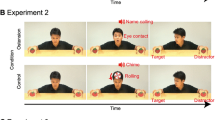Abstract
Chimpanzees appear to understand something about the attentional states of others; in the present experiment, we investigated whether they understand that the attentional state of a human is based on eye gaze. In all, 116 adult chimpanzees were offered food by an experimenter who engaged in one of the four experimental manipulations: eyes closed, eyes open, hand over eyes, and hand over mouth. The communicative behavior of the chimpanzees was observed. More visible behaviors were produced when the experimenter's eyes were visible than when the experimenter's eyes were not visible. More vocalizations were produced when the experimenter's eyes were closed than when they were open, but there were no differences in other attention getting behaviors. There was no effect of age or rearing history. The results suggest that chimpanzees use the presence of the eyes as a cue that their visual gestures will be effective.


Similar content being viewed by others
Notes
The focal chimpanzee did not typically direct any communicative behaviors toward E2, because E1 clearly had the food. On the rare occasion that a communicative behavior was directed toward E2, it was not recorded.
References
Agnetta B, Hare B, Tomasello M (2000) Cues to food location that domestic dogs (Canis familiaris) of different ages do and do not use. Anim Cogn 3:107–112
Baldwin DA, Moses LJ (1994) Early understanding of referential intent and attentional focus: Evidence from language and emotion. In: Lewis C, Mitchell P (eds) Children's early understanding of mind: origins and development. Erlbaum, Hillsdale, NJ, pp 133–156
Brauer J, Call J, Tomasello M (2005) All great ape species follow gaze to distant locations and around barriers. J Comp Psychol 119:145–154
Brooks R, Meltzoff AN (2003) The importance of eyes: how infants interpret adult looking behavior. Dev Psychol 38:701–711
Butterworth G, Jarrett N (1991) What minds have in common is space: spatial mechanisms serving joint visual attention in infancy. Br J Dev Psychol 9:55–72
Cheney DL, Seyfarth RM (1990) Attending to behaviour versus attending to knowledge: examining monkeys' attributions of mental states. Anim Behav 40:742–753
Franco F, Butterworth G (1996) Pointing and social awareness: declaring and requesting in the second year. J Child Lang 23:307–336
Goodall J (1986) The chimpanzees of gombe: patterns of behavior. Harvard University Press, Cambridge
Hare B (2001) Can competitive paradigms increase the validity of experiments on primate social cognition? Anim Cogn 3:269–280
Hare B, Tomasello M (1999) Domestic dogs (Canis familiaris) use human and conspecific social cues to locate hidden food. J Comp Psychol 113:173–177
Heyes CM (1998) Theory of mind in nonhuman primates. Behav Brain Sci 21:101–148
Hostetter AB, Cantero M, Hopkins WD (2001) Differential use of vocal and gestural communication by chimpanzees (Pan troglodytes). J Comp Psychol 115:337–343
Kaminski J, Call J, Tomasello M (2004) Body orientation and face orientation: two factors controlling apes' begging behavior from humans. Anim Cogn 7:216–223
Krause MA, Fouts RS (1997) Chimpanzee (Pan troglodytes) pointing: hand shapes, accuracy, and the role of eye gaze. J Comp Psychol 111:330–336
Leavens DA, Hopkins WD (1998) International communication by chimpanzees: a cross-sectional study of the use of referential gestures. Dev Psychol 34:813–822
Leavens DA, Hostetter AB, Wesley MJ, Hopkins WD (2004) Tactical use of unimodal and bimodal communication by chimpanzees (Pan troglodytes). Anim Behav 67:467–476
Liebal K, Call J, Tomasello M (2004) Use of gesture sequences in chimpanzees. Am J Primatol 64:377–396
Povinelli DJ (2003) Folk physics for apes: the chimpanzees theory of how the world works. Oxford University Press, Oxford
Povinelli DJ, Eddy TJ (1996a) Chimpanzees: joint visual attention. Psychol Sci 7:129–135
Povinelli DJ, Eddy TJ (1996b) Factors influencing young chimpanzees' (Pan troglodytes) recognition of attention. J Comp Psychol 110:336–345
Reaux JE, Theall LA, Povinelli DJ (1999) A longitudinal investigation of chimpanzees’ understanding of visual perception. Child Dev 70:275–290
Theall LA, Povinelli DJ (1999) Do chimpanzees tailor their gestural signals to fit the attentional states of others? Anim Cogn 2:207–214
Tomasello M, Call J, Hare B (1998) Five primate species follow gaze direction geometrically. Anim Behav 58:769–777
Tomasello M, Call J, Nagell K, Olguin R, Carpenter M (1994) The learning and use of gestural signals by young chimpanzees: a trans-generational study. Primates 35:137–154
Acknowledgments
This work was supported in part by NIH grants RR-00165, NS-29574, NS-36605, NS-42867, and HD-38051. We thank Sara Shonka for her help with data collection.
Author information
Authors and Affiliations
Corresponding author
Rights and permissions
About this article
Cite this article
Hostetter, A.B., Russell, J.L., Freeman, H. et al. Now you see me, now you don't: evidence that chimpanzees understand the role of the eyes in attention. Anim Cogn 10, 55–62 (2007). https://doi.org/10.1007/s10071-006-0031-x
Received:
Revised:
Accepted:
Published:
Issue Date:
DOI: https://doi.org/10.1007/s10071-006-0031-x




